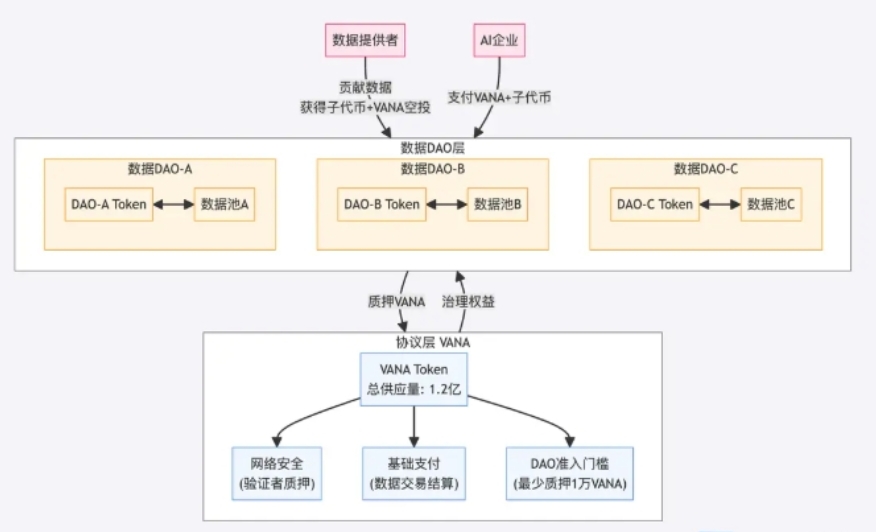Review of Vana: From the laboratory to Binance, you have the final say on your data

Reprinted from panewslab
12/17/2024·6MVana is listed on Binance, the price is very beautiful, some people are happy and some are sad.
Those who play with multiple accounts are excited, as the cycle is short and the returns are high; those who speculate in NFT are also excited, earning a crotch of ETH in a short period of time. However, due to the snapshot time issue, it is a bit uncomfortable for secondary NFTs to be purchased at high prices.
In contrast, BNB holders are really enjoying stable happiness. The income of this period seems to be higher than that of the previous periods, and recently there were airdrops from Lanchpool and HODLer. The golden shovel of BNB kept digging and digging, and the big investors enjoyed it.
To be honest, I knew about the VANA project before, but I didn’t expect the coins to be issued so quickly. Now I can only watch you make a fortune. Next, let’s not talk about right and wrong, but simply review what VANA does and why it can be listed on Binance. This may be helpful for subsequent potential projects.
1. Originated from the Massachusetts Laboratory
Public information shows that the birth of Vana can be traced back to a classroom in the MIT Media Lab.
There, Anna Kazlauskas and Art Abal met. They are obsessed with data democratization and hope that through their own efforts, users can truly control their own data, so they jointly founded Vana.
Subsequently, the Vana team used the innovative DLP (Data Liquidity Pool) mechanism and Proof of Contribution system to allow users to safely contribute private data, jointly own and benefit from the AI models trained by these data.
Their efforts were quickly recognized by the industry. A total of US$25 million in financing was completed before TGE, with investors including top VCs such as Coinbase Ventures, Paradigm, and Polychain.

Now that they have successfully landed on Binance, it is regarded as a victory for the academic school, and it is also an inspiration to young people who aspire to change the world.
2. Cooperate and interact with the a16z team
Some time ago, a16z partners released a list of AI projects worthy of attention, and Vana was the only Web3 project mentioned.
Interestingly, a16z is not an investor in Vana, which also reflects Vana’s influence in the industry.
Co-founder Art admitted in an interview that although a16z did not directly invest in Vana, he received a lot of indirect and informal support from a16z.
"I think the reason they've been so helpful to us is that we're so aligned in our goals of pushing Web3 forward. We want to make Web3 more accessible and make sure it solves real problems."
3. Data DAOs are blooming everywhere
DLP (Data Liquidity Pool) is the core function of the Vana ecosystem. Users obtain tokens by contributing data, forming so-called data liquidity. Each data DAO or liquidity pool focuses on a specific type of data.
For us, this is actually similar to "data mining": when you are optimistic about a certain DAO, you directly contribute data according to their rules, and then you will receive corresponding rewards and airdrops.
Public data shows that since the launch of the developer testnet in June 2024, the Vana network has attracted 1.3 million users, more than 300 data DAOs and a daily transaction volume of 1.7 million.
4.Dual-layer token economic model
In the Vana ecosystem, data DAOs, large and small, have their own sub-coins, which are also related to the parent currency $VANA (such as airdrops, etc.).
This is the two-layer token economic model designed by Vana: setting up a unified basic token $VANA at the protocol level, while allowing each data DAO to issue its own exclusive token. The mother currency and sub-coins have different divisions of labor and functions.

To give a simple example, each data DAO must stake at least 10,000 $VANA to operate. In this way, the value of the mother currency is directly tied to the ecological construction, and both are prosperous.
5. Uncertainty about future development
From the perspective of design concept, the emergence of Vana marks that the data economy is ushering in a paradigm change. However, Vana's ultimate success still faces many uncertainties.
Rhythm once summarized this: Technically, it needs to find a balance between openness and security; Economically, it needs to prove that its model can generate sustained value; Socially, it also needs to deal with potential data ethics and Regulatory challenges.
No matter what, Vana provides us with a window to rethink data value, AI ethics and technological innovation. We look forward to more innovative projects in this field in the future to help the data economy take off.


 jinse
jinse
 chaincatcher
chaincatcher